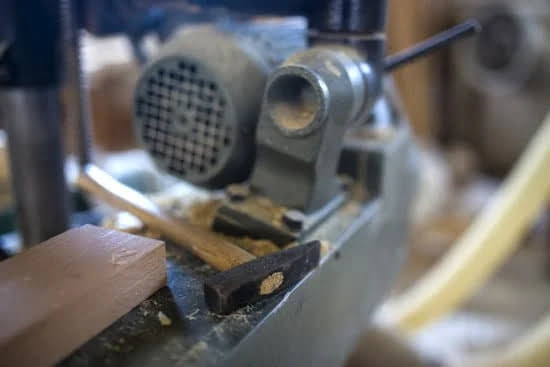Are you interested in setting up a beginner woodworking shop? Woodworking is a fulfilling and rewarding hobby that allows you to create beautiful, functional pieces with your own hands. Whether you’re a complete novice or have some experience, this comprehensive guide will help you get started on the right foot. From selecting the essential tools and materials to mastering basic techniques and creating your first project, we’ve got you covered.
Woodworking is a timeless craft that has been practiced for centuries, and it’s not difficult to see why. The satisfaction that comes from seeing a piece of raw wood transform into a handcrafted work of art is unparalleled. In this article, we’ll explore the basics of woodworking, helping you lay down a solid foundation for your new hobby or profession.
Before diving into the world of woodworking, it’s important to understand the essential tools needed to set up your beginner woodworking shop. From saws and drills to measuring tools and safety gear, having the right equipment is crucial for success. We’ll provide you with a comprehensive guide on what tools to invest in as well as tips for budget-friendly options. So, let’s get started on this exciting journey of setting up a beginner woodworking shop.
The Essential Tools for a Beginner Woodworking Shop
If you’re interested in setting up a beginner woodworking shop, one of the most crucial steps is acquiring the essential tools for your space. Investing in high-quality tools will not only make your woodworking projects easier, but it will also ensure that you are working safely and efficiently. Here is a comprehensive guide to the must-have tools for any beginner woodworking shop.
One of the first tools you’ll need in your woodworking shop is a good quality saw. A circular saw is versatile and can handle a variety of cuts, making it an essential tool for any beginner woodworker. Additionally, a jigsaw is great for making curved or intricate cuts, while a miter saw is perfect for cutting precise angles.
In addition to saws, having measuring and marking tools is vital for accurate woodworking. A tape measure, combination square, and marking gauge are essential for ensuring your cuts and measurements are precise. You’ll also want to invest in clamps to hold your wood securely in place as you work on it.
A combination of bar clamps, pipe clamps, and spring clamps will give you versatility in holding different sizes and shapes of materials. By starting with these essential tools, you’ll be well on your way to setting up a functional beginner woodworking shop.
Setting Up Your Workspace
When it comes to setting up a beginner woodworking shop, creating an efficient and safe workspace is crucial. This section will provide you with tips and guidelines to help you optimize your woodworking environment for productivity and safety.
Organizing Your Tools and Equipment
One of the first steps in setting up your woodworking shop is organizing your tools and equipment. A well-organized workspace not only makes it easier to find what you need, but it also increases efficiency and reduces the risk of accidents.
Consider investing in tool racks, shelves, and cabinets to keep your tools organized and easily accessible. It’s also important to have a designated space for each tool to ensure that they are stored safely when not in use.
Optimizing Your Layout
In addition to organizing your tools, optimizing the layout of your workspace is essential for creating an efficient woodworking shop. Consider factors such as workflow, accessibility, and safety when planning the layout of your shop. For example, placing larger power tools in areas where there is ample space for maneuvering can help prevent accidents. Additionally, ensuring that workbenches are positioned in well-lit areas can improve visibility and reduce the likelihood of mistakes.
Prioritizing Safety Measures
Safety should be a top priority when setting up a beginner woodworking shop. Make sure to equip your workspace with essential safety gear such as goggles, ear protection, dust masks, and gloves. It’s also important to have fire extinguishers on hand in case of emergencies.
Furthermore, consider implementing safety protocols such as keeping floors free of clutter and ensuring that all electrical outlets are properly grounded. By prioritizing safety measures from the start, you can create a workspace that promotes safe woodworking practices for years to come.
Choosing the Right Materials
Woodworking is a craft that relies heavily on the quality of materials used. When setting up a beginner woodworking shop, it’s essential to understand wood selection and quality to ensure the success of your projects. There are various factors to consider when choosing the right materials for your woodworking endeavors.
One important consideration when choosing wood is the type of project you’re working on. Different types of wood have various properties that make them suitable for specific projects. For example, hardwoods like oak and cherry are great for furniture-making due to their strength and durability, while softwoods like pine and cedar are ideal for outdoor projects because of their resistance to rot and insects.
Another crucial factor in wood selection is the grade and quality of the lumber. Higher grades of wood will have fewer knots, blemishes, and warping, which can make them easier to work with and result in higher-quality finished products. Understanding how to identify these characteristics will help you choose the best materials for your projects.
Lastly, it’s important to consider where you source your materials. Local lumberyards and specialty wood suppliers can offer a wide variety of high-quality woods, often with the option to select specific pieces based on your preferences. Additionally, some beginners may choose to repurpose old or salvaged wood for their projects, adding a sustainable element to their woodworking practice.
| Factors in Wood Selection | Considerations |
|---|---|
| Type of Project | Different types of wood are suitable for different types of projects. |
| Grade and Quality | Higher grades of wood will have fewer blemishes and warping. |
| Sourcing Materials | Local lumberyards or specialty suppliers are good sources for high-quality woods. |
Basic Woodworking Techniques
Measuring and Marking
One of the most important techniques in woodworking is the ability to accurately measure and mark your wood. A good quality tape measure, combination square, marking gauge, and marking knife are essential tools for this task. Learning to use these tools accurately will ensure that your projects are well-constructed and precise.
Cutting and Shaping
Understanding how to properly cut and shape wood is crucial for any woodworking project. The most common tools for this task include a hand saw, circular saw, jigsaw, and router. Each tool has its own specific uses and learning the proper techniques for using them will greatly improve your woodworking skills.
Joinery
Creating strong joints is an essential skill in woodworking. There are many different types of joinery techniques including butt joints, dovetail joints, mortise and tenon joints, and more. Learning how to properly create these joints will allow you to construct sturdy and durable furniture and other woodworking projects.
By mastering these basic woodworking techniques, you will be better equipped to tackle a wide range of woodworking projects with confidence. These fundamental skills will set you on the path to becoming a skilled woodworker as you continue to expand your knowledge and experience in the craft of woodworking.
Organizing Your Shop
When setting up a beginner woodworking shop, one of the key elements to consider is how to effectively organize your space to maximize efficiency and safety. Proper storage solutions and thoughtful layout planning can make a significant difference in the functionality of your workshop.
One important aspect to address when organizing your shop is storage solutions for your tools, materials, and projects in progress. Having designated areas for each type of tool or material will not only keep your workspace tidy but also make it easier to find what you need when you need it. Consider investing in wall-mounted racks, shelving units, and tool chests to keep everything organized and within reach.
In addition to storage solutions, careful layout planning is essential for a beginner woodworking shop. You’ll want to ensure that there is enough space for maneuvering around large pieces of wood, as well as having dedicated areas for cutting, sanding, and assembling projects. By creating separate zones for different tasks, you can streamline your workflow and minimize the risk of accidents.
Another important consideration when organizing your shop is creating a comfortable and safe working environment. Be mindful of potential hazards such as tripping hazards or cluttered workbenches, and take the time to evaluate the ergonomics of your workspace. A well-organized shop not only contributes to better productivity but also reduces the likelihood of accidents or injuries.
Safety First
When setting up a beginner woodworking shop, safety should be the top priority. Working with wood and power tools can pose potential hazards, so it is essential to prioritize the safety of yourself and others in your workspace. Here are some tips for ensuring a safe woodworking environment:
- Invest in proper safety gear: This includes items such as safety glasses, ear protection, and a dust mask to protect yourself from flying debris, loud noises, and harmful particles.
- Keep your work area well-lit: Good lighting is crucial for visibility and reducing the risk of accidents while using sharp tools.
- Learn how to use tools safely: Before using any power tool or hand tool, take the time to read the manual and understand proper usage. Always follow manufacturer guidelines for safe operation.
In addition to these practices, it is important to maintain a clean and organized workspace. Cluttered or disorganized areas can lead to accidents or injuries. Proper storage solutions for your tools and materials can help prevent tripping hazards and keep your workspace clear for efficient work.
Lastly, always be mindful of your posture and body mechanics when working with wood. Using proper lifting techniques and taking breaks when needed can help prevent strain or injury. By following these safety practices, you can create a secure environment in which to enjoy your woodworking hobby or craft effectively.
Building Your First Project
Now that you have your beginner woodworking shop set up and all the essential tools in place, it’s time to embark on your first project. Starting with a simple project will allow you to practice basic woodworking techniques and gain confidence in using your tools. Here are some step-by-step instructions for a beginner woodworking project:
Building a Wood Toolbox
To start, gather the following materials for your wood toolbox project:
- 1 piece of 1×6 lumber, 24 inches long
- Wood glue
- 1-inch brad nails
- Sandpaper
- Wood finish or paint
Next, follow these steps to build your wood toolbox:
- Cut the 1×6 lumber into the following pieces: two 24-inch long pieces for the sides, one 22-inch long piece for the bottom, and two 8-inch long pieces for the ends.
- On one of the side pieces, measure and mark where you want the handle to be located. Use a saw to carefully cut out this portion of the wood.
- Apply wood glue to the edges of the bottom piece and attach it between the two side pieces to form a box shape.
- Attach the end pieces to each end of the box using wood glue and brad nails.
- Sand any rough edges and surfaces until smooth, then apply a wood finish or paint as desired.
Once your wood toolbox is complete, you can use it to store and organize your woodworking tools, making it both a practical and satisfying first woodworking project.
Remember to take your time with each step, double-check measurements, and prioritize safety throughout the building process. Following these step-by-step instructions will help you build confidence in your woodworking skills as you complete your first project in your newly established beginner woodworking shop.
Resources for Continued Learning
As you continue to develop your skills and knowledge in woodworking, it’s important to seek out resources for continued learning. Whether you’re looking for hands-on classes, informative workshops, or a supportive online community, there are plenty of options available to help you expand your expertise. By taking advantage of these resources, you can further enhance your woodworking abilities and connect with fellow enthusiasts who share your passion for the craft.
One valuable resource for continued learning is local woodworking classes and workshops. These can provide you with the opportunity to learn from experienced instructors, gain practical skills through hands-on projects, and interact with other aspiring woodworkers. Additionally, these in-person settings allow you to ask questions, receive personalized guidance, and build a network within the woodworking community.
In addition to traditional classes and workshops, online communities offer a wealth of knowledge and support for woodworking enthusiasts. Forums, social media groups, and online platforms dedicated to woodworking provide a space for sharing ideas, asking for advice, and showcasing your own projects.
Engaging with these communities allows you to learn from others’ experiences, stay updated on industry trends, and connect with like-minded individuals who can inspire and motivate you in your woodworking journey. So as you set up your beginner woodworking shop, remember that the learning process doesn’t end there – there are countless opportunities for growth and enrichment within the vibrant world of woodworking.
Frequently Asked Questions
How Do I Set Up a Woodworking Workshop?
Setting up a woodworking workshop requires careful planning and consideration of the space, tools, and equipment needed. Begin by choosing a suitable location with adequate ventilation and lighting. Invest in essential tools such as a table saw, band saw, drill press, and hand tools. Organize the layout of the workshop to maximize efficiency and safety.
What Do You Need to Start a Small Woodworking Business?
To start a small woodworking business, you’ll need to have a solid business plan in place. This includes identifying your target market, setting competitive pricing, and acquiring necessary permits or licenses. You’ll also need a range of high-quality woodworking tools and materials, as well as a dedicated workspace for your projects.
What Is a Good Size for a Hobby Woodworking Shop?
A good size for a hobby woodworking shop depends on the types of projects you plan to undertake and the available space. Generally, a shop around 400-600 square feet can accommodate basic machinery and workbenches while allowing for comfortable movement and storage. It’s important to prioritize organization and accessibility within the space to enhance productivity.

Hi everyone! I’m a woodworker and blogger, and this is my woodworking blog. In my blog, I share tips and tricks for woodworkers of all skill levels, as well as project ideas that you can try yourself.





